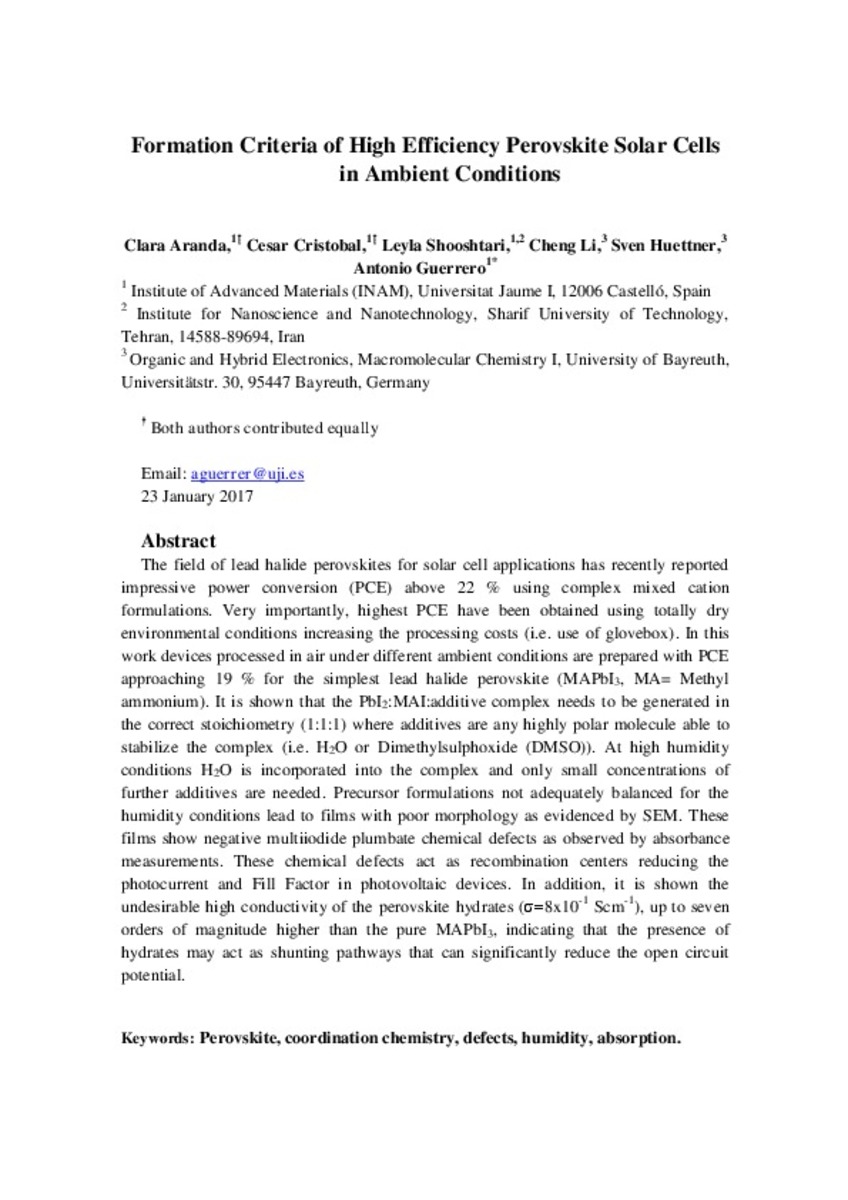| dc.contributor.author | Aranda Alonso, Clara | |
| dc.contributor.author | Cristobal, Cesar | |
| dc.contributor.author | Shooshtari, Leyla | |
| dc.contributor.author | Li, Cheng | |
| dc.contributor.author | Huettner, Sven | |
| dc.contributor.author | Guerrero, Antonio | |
| dc.date.accessioned | 2018-01-23T15:56:24Z | |
| dc.date.available | 2018-01-23T15:56:24Z | |
| dc.date.issued | 2017 | |
| dc.identifier.citation | Aranda, C., Cristobal, C., Shooshtari, L., Li, C., Huettner, S., & Guerrero, A. (2017). Formation criteria of high efficiency perovskite solar cells under ambient conditions. Sustainable Energy & Fuels, 1(3), 540-547. | ca_CA |
| dc.identifier.issn | 2398-4902 | |
| dc.identifier.uri | http://hdl.handle.net/10234/172139 | |
| dc.description.abstract | The field of lead halide perovskites for solar cell applications has recently reported impressive power conversion (PCE) above 22 % using complex mixed cation formulations. Very importantly, highest PCE have been obtained using totally dry environmental conditions increasing the processing costs (i.e. use of glovebox). In this work devices processed in air under different ambient conditions are prepared with PCE approaching 19 % for the simplest lead halide perovskite (MAPbI3, MA= Methyl ammonium). It is shown that the PbI2:MAI:additive complex needs to be generated in the correct stoichiometry (1:1:1) where additives are any highly polar molecule able to stabilize the complex (i.e. H2O or Dimethylsulphoxide (DMSO)). At high humidity conditions H2O is incorporated into the complex and only small concentrations of further additives are needed. Precursor formulations not adequately balanced for the humidity conditions lead to films with poor morphology as evidenced by SEM. These films show negative multiiodide plumbate chemical defects as observed by absorbance measurements. These chemical defects act as recombination centers reducing the photocurrent and Fill Factor in photovoltaic devices. In addition, it is shown the undesirable high conductivity of the perovskite hydrates (8x10-1 Scm-1), up to seven orders of magnitude higher than the pure MAPbI3, indicating that the presence of hydrates may act as shunting pathways that can significantly reduce the open circuit potential. | ca_CA |
| dc.format.extent | 17 p. | ca_CA |
| dc.format.mimetype | application/pdf | ca_CA |
| dc.language.iso | eng | ca_CA |
| dc.publisher | Royal Society of Chemistry | ca_CA |
| dc.relation.isPartOf | Sustainable Energy & Fuels, 2017, vol. 1, no 3, p. 540-547. | ca_CA |
| dc.rights | Aranda, C., Cristobal, C., Shooshtari, L., Li, C., Huettner, S., & Guerrero, A. (2017). Formation criteria of high efficiency perovskite solar cells under ambient conditions. Sustainable Energy & Fuels, 1(3), 540-547. <http://dx.doi.org/10.1039/C6SE00077K> -- Reproduced by permission of The Royal Society of Chemistry
This journal is © The Royal Society of Chemistry 2017 | ca_CA |
| dc.rights.uri | http://rightsstatements.org/vocab/InC/1.0/ | * |
| dc.subject | perovskite | ca_CA |
| dc.subject | coordination chemistry | ca_CA |
| dc.subject | defects | ca_CA |
| dc.subject | humidity | ca_CA |
| dc.subject | absorption | ca_CA |
| dc.title | Formation Criteria of High Efficiency Perovskite Solar Cells in Ambient Conditions | ca_CA |
| dc.type | info:eu-repo/semantics/article | ca_CA |
| dc.identifier.doi | http://dx.doi.org/10.1039/C6SE00077K | |
| dc.relation.projectID | We thank financial support by MINECO of Spain under project (MAT2013-47192-C3-1-R), and Generalitad Valenciana is acknowledged for financial support on the DISOLAR2 Project (PROMETEOII/2014/020). A. G. would like to thank the Spanish Ministerio de Economía y Competitividad for a Ramón y Cajal Fellowship (RYC-2014-16809). | ca_CA |
| dc.rights.accessRights | info:eu-repo/semantics/openAccess | ca_CA |
| dc.relation.publisherVersion | http://pubs.rsc.org/is/content/articlehtml/2017/se/c6se00077k | ca_CA |
| dc.type.version | info:eu-repo/semantics/submittedVersion | ca_CA |







